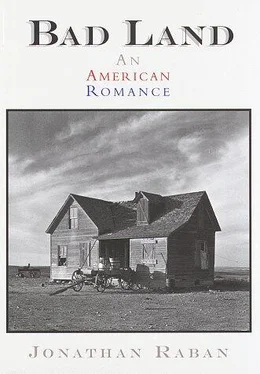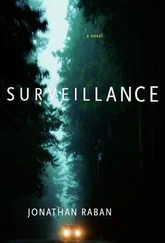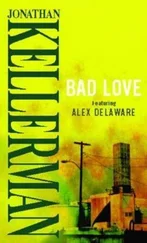Seventy-five miles on (though it seemed just a short way down the road), I stopped at Forsyth, a pint-sized Miles City without the nuns and bureaucrats, for the Rosebud County museum. At first, I thought the museum was the usual rummage-sale assortment of old clothes, tools, utensils, photographs and other oddments, salvaged from basements and smelling powerfully of camphor; hardly worth stopping for. I was digging in my wallet for a dollar to put in the voluntary box when I saw the museum’s unique treasure: the Larsen Collection, of early barbed wire.
Stapled to sheets of Peg-Board, neatly labeled in Dynotape, were several hundred short lengths of rusty fence wire. Glidden’s Round Square Variation … Cline’s Rail … Fentress Diamond … Kennedy 3-Point … Every conceivable variety of barb was represented — from thorns to arrowheads to crescent blades. The exhibit was a revelation. I would never have guessed that the barbed wire world was so large, intricate and full of unexpected subtleties.
I couldn’t come up with any very sophisticated interpretation of what I saw. The 1870s were the golden age of barbed wire, when dozens of competing manufacturers were trying to outdo each other with experiments and innovations. By the time the homesteaders arrived, barbed wire had sunk into a period of relatively dull conformity, and Glidden’s “The Winner” had more or less scooped the pool. Then the First World War revived the art, with wire designed to resist cutters and inflict as many injuries as possible on entangled humans.
That was about as far as I could go. A connoisseur would have been able to see each piece as an attempted solution to an earlier problem, and would have been able to read in the Larsen Collection a detailed history of the fencing of the West. He’d explain the introduction of the plate-block and the chain-link in terms of what had happened on the prairie in 1874, and why this particular contrivance had seemed to be such a good idea in 1875. 1 badly wanted to meet Mr. Larsen.
“He passed away,” said the volunteer who was minding the museum for the afternoon. She had spent the last fifteen minutes following my rapt scrutiny of bits of wire; her interest in me was tinged, I thought, with mild alarm. The Larsen Collection was apparently not a common object of pilgrimage. “He owned a garage in town, but barb-wire was his big hobby. He traveled everywhere for barb-wire. Used to go to barb-wire conventions. He went to Chicago, Kansas City …”
The oddity of Mr. Larsen’s life got the better of her. She giggled.
“I heard he paid a thousand dollars for one piece of barbwire. It was this long.” She framed six inches between her fingers. “A thousand dollars.”
“It’s a magnificent collection.”
“We’ve got a whole lot of other stuff you might want to see—”
“I couldn’t. I just want to spend a little longer with the barbed wire, if I may.”
She had decided I was harmless. “I never paid much attention to barb-wire. Except once, when I was a girl. I was wearing my best dress, and it got tore on the barb-wire, from here … to here.” She smiled fondly at this memory, and I left her to enjoy it alone.
At Forsyth, the Milwaukee Road parted company with the Yellowstone River and the Northern Pacific, and struck out on a northwesterly bearing across the open plain. US 12 ran alongside the abandoned track, whose crumbling embankment, breached in many places, was marked by a broken line of dwarfish telegraph posts, leaning at all angles. These black wooden crosses made the railroad look like the serial graveyard that it really was.
There was a surprising amount of up-and-down on this stretch. Aiming for the comfortable route of the Musselshell Valley, and impatient with the intervening topography, Earling had driven his railroad straight across seventy miles of dry and bumpy country. No creeks, no trees, no coulees, no buttes, no sheltering bluffs, no shape to it at all. Even the snowy clumps of sagebrush looked lonely as they shivered in the nearly gale-force wind. But Earling sowed towns along this exposed and desolate reach of land at the same regular intervals as the towns he planted along the line of Fallon Creek.
At Vananda, a gaunt, brick, narrow-windowed, three-story school, like a defunct prison, reared over a woodpile of flattened shacks.
At Ingomar, ragged ears of tar paper flapped from the bare frames of the few undemolished houses. But people still lived here — in a cluster of trailers surrounding the Jersey Lilly bar, whose walls were hung, improbably, with African hunting trophies. Nothing else in the bar chimed with the faded country-house chic of these slain wildebeests and springboks.
At Sumatra, which was little more than a heap of auto parts, fencing wire and railroad ties, the only visible inhabitant was a dog, with a bit of collie in it, who approached the Jeep and offered me his or her bone.
Even the Milwaukee Road Pamphleteer of 1910 sounded a good deal more cautious than usual when he eulogized the area:
This section … has until recently been kept from developing through lack of transportation facilities. On the bench … are found immense areas of gently undulating prairie land excellently adapted to farming without irrigation. The country is so new that not much has yet been accomplished in the way of actual farming, but enough has been done to demonstrate its feasability.
Yet this dour country — more inhospitable by far than the land around Ismay — was homesteaded, pretty much from end to end. The giveaway tracks in the snow confirmed it. Now there wasn’t a hint of cultivation, and not even a sheep or cow in sight. High up, a patient hawk dipped and wheeled, searching for signs of life below. In November on this prairie, a raptor could go hungry.
When the line was freshly laid, Albert J. Earling chugged through here in the presidential railroad car, giving names to vacancies. A reporter, on assignment from a Chicago paper, was in his entourage. As the line bent sharply southwest, to fall in with the flat little valley of the Musselshell River, and another name was called for, Earling turned to the reporter.
“What did you say your name was?”
“Melvin Stone.”
Earling said, Let there be Melstone: and there was Melstone.
A forlorn grid of dirt streets and moldering shacks. When they could afford it, Melstone families had deserted the shacks and moved into trailers in their yards, but there did not seem much to choose between their old and their new accommodation. Junked automobiles stood where they had stopped in the 1950s and ’60s. Bereft of glass and every salvageable moving part, their rusted shells had come to look like the Melstone version of civic sculpture. There was a general store, two bars, three churches (Faith Lutheran, Congregational Bible, Our Lady of Mercy), a U.S. Post Office, and Melstone High School, Home of the Broncs. The school looked like the kind of place where sensitive types got beaten to a pulp in the yard.
Melstone appeared to have fallen clean through the net of white North America. It would not have been out of place in Senegal or Guinea-Bissau, this sorry accumulation of makeshift shelters, scrap metal and mud. Only the satellite dishes betrayed the fact that Melstone was in the same state as the Ted Turner ranch and the Whoopi Goldberg log cabin. I thought, if I lived in Melstone, I’d ache for a transcendent world, and take to drink, religion or HBO.
But the Musselshell valley was the beginning of something new. A few miles on from Melstone, there were harvested wheat fields, water meadows, dairy cattle. Sandstone bluffs, black with pines, crowded the road — almost a forest! To the tree-starved people on the train, this sudden, promising coincidence of woods and water must have stirred their blood. Children had never seen a landscape like this — tall, green, full of perspectives. For the first time, they were looking out at “scenery”—nature arranging itself like a theater. Parents found memories to fit the view. From the pleasant small town of Musselshell, through Delphia and Gage, I was half in Montana, half in Devon, where the same red sandstone clifflets squeeze the upper reaches of the Exe and Dart.
Читать дальше












